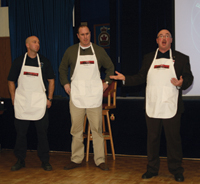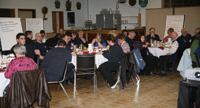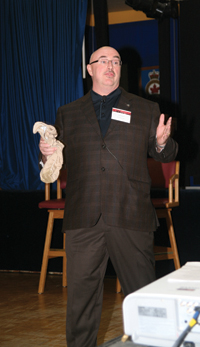
Department news
News
Looking toward Vision 2014
Lt. Steve Adams is passionate about firefighting and his role as the instructor and volunteer co-ordinator with Langford Fire Rescue in British Columbia. When he approached Chief Bob Beckett last November with a list of concerns ranging from apparatus issues to volunteer turnout, he wanted to be part of the solution.
November 6, 2009
By Linda Hunter
Lt. Steve Adams is passionate about firefighting and his role as the instructor and volunteer co-ordinator with Langford Fire Rescue in British Columbia. When he approached Chief Bob Beckett last November with a list of concerns ranging from apparatus issues to volunteer turnout, he wanted to be part of the solution.
Chief Beckett concurred with Lt. Adams’ observations and wanted to create a process through which the department would embrace the changes that Adams and others were advocating.
 |
|
| Langford Fire Rescue Lt. Steve Adams (left), Chief Bob Beckett (right) and Phil Ohl with The Leader’s Edge leadership training and coaching organization host a café-style evening for LFR stakeholders to help develop a five-year vision statement for the department. Photo courtesy LFR |
Beckett brought in consultant and long-time friend Phil Ohl from The Leader’s Edge (www.leadersedge.ca ), a Victoria-based leadership training and coaching organization. Ohl helped LFR produce a vision statement and guidelines for the next five years through a process called Vision 2014. Key to the process was the inclusion of stakeholders, including firefighters and municipal politicians, to ensure a thorough understanding of the department’s new direction and 100 per cent participation in the changes that would follow.
Beckett and Adams, with Ohl’s help, invited firefighters, community leaders and others to a coffee-house type evening in early 2009 to share concerns and ideas and participate in the formulation of the department’s new vision.
■ The background
With more than 69 volunteer and full-time personnel in three stations, Adams spends much of his time listening to and watching the volunteers.
“Having a compliment of both volunteer and paid firefighters is a an asset as they work together to meet the needs of an ever growing community, needs that include more complicated building structures, higher training standards and improved response times,” he says.
“We have always had the expectation that a firefighter is a firefighter, paid or unpaid. We expect a lot of our volunteers; they give a tremendous number of hours, so it’s important to continue to develop a common agenda that is inclusive of everybody.”
Langford Fire Rescue’s concerns or challenges may be familiar to other Canadian volunteer and composite departments:
- standards of response coverage;
- equipment and apparatus needs;
- the potential for future collective agreement changes and the related impact on service levels;
- a projected 10 per cent increase in call volume per year based on municipal growth that would challenge sustainability for volunteers and career staff;
- response times to fire stations by volunteers (which had increased significantly due to the impact of growth/traffic duty officer rotation schedules);
- volunteer turnout to alarm-bell type calls;
- and the implementation of any changes deemed necessary to deal with the above issues.

|
|
| Stakeholders including firefighters, the women’s auxiliary, amateur radio aficionados and municipal politicians brainstorm to determine how to bring positive change to the department to address issues such as standards of response coverage and equipment and apparatus needs. Photo courtesy LFR |
Chief Beckett was pragmatic about the concerns that Adams and others brought forward, viewing them not as criticism, rather as a challenge to improve the department and push its personnel to perform at their highest levels.
“I think we created an organization over the past 13 years that embraces change and encourages individuals to challenge the status quo,” Chief Beckett said. “I believe that the rubber band was losing some of its tension as we accomplished a number of goals in the past, and when we had a moment to take stock, we recognized the opportunity for re-stretching ourselves and take it (us) to the next level.”
In his almost 14 years as LFR chief, Beckett had ensured that along with technical training his personnel received formalized leadership and development training, resulting in a culture that embraces change. Consequently, inviting an outside agency to help management deal with the department’s issues was viewed as a positive step rather than with fear or skepticism.
Considering LFR’s longstanding relationship with Ohl, “bringing Phil in was not like bringing in someone from the outside,” Beckett said. “We consider this a relationship. He was brought in to compliment our efforts, as a resource, no different than any other training or education resource at our disposal. We wanted to take a pro-active approach, move forward and make a good thing even better. We didn’t bring Phil in to fix anything; we wanted another perspective, a technical advisor who could help us see through another set of lenses.”
■ The process
The key to the Vision 2014 process was inclusion. In January, more than 80 guests representing stakeholder groups including city counsellors, emergency social service reps, fire dispatchers, full-time and volunteer firefighters, members of the women’s auxiliary and amateur radio aficionados gathered for the coffee-house evening and workshop.
In his opening remarks, Beckett told the group that change is possible but that it requires ”patience nurturing and diplomacy”.
With Beckett, Adams and Ohl in aprons and acting as servers to lighten the mood and promote frank discussion, guests watched motivational videos and were then asked to answer three questions:
- What is a source of pride for you in the work you do, or in the relationship you have with LFR?
- Imagine you just woke up after being asleep for five years. What does LFR look like?
- What attributes of our current organization give you hope and optimism for our future?
The conversations culminated with many stakeholders delivering messages about what was right with LFR, what they believed wasn’t working and what they wanted to see changed. Areas of discussion included safety, training, volunteerism, values, operations and department models, staffing and education. The first phase of Vision 2014 was considered a success but the work had just begun. The next step was the formation of a committee to develop a vision statement based on the workshop results. Over the next few weeks the committee, made up of 12 members representing all the stakeholder groups along with Adams and Beckett, met with Ohl and developed the vision statement that they felt represented LFR: Working together, leading globally.
Since the birth of that vision statement, Beckett and his staff have developed a worksheet of issues and opportunities relating to the top 15 challenges identified in the Vision 2014 process and have selected six on which to focus:
- Working collectively with internal (municipal) and external resources to provide the best possible services for those in need;
- Creating an organization (a combination or composite fire department model) that others will wish to mirror or to which others will aspire;
- Developing relationships with all of stakeholders to ensure 100 per cent buy in and co-operation in reaching objectives;
- Continuing to develop a training program that ensures that volunteers and career staff alike are trained to the highest standards;
- Providing the department with equipment and apparatus that ensures optimum safety coupled with a focus on proficiency, effectiveness and efficiency;
- Focusing on sustainability for its volunteers and career staff by ensuring that their experience while with LFR is second to none.
 |
|
| Langford Fire Chief Bob Beckett has ensured in his almost 14 years at the helm that his personnel received formalized leadership and personnel development training, resulting in a culture that has embraced change. Photo courtesy LFR |
■ The results
Both the chief and Adams believe that without Vision 2014, there would be more frustrations, more misdirected energies and a lack of goal setting. Beckett and Adams continue to meet regularly with the various groups in the organization, for example the women’s auxiliary and the firefighters, to keep the Vision 2014 process alive.
Beckett and Adams agree that not a week goes by that the vision statement is not in use – it’s used to filter every decision, whether its the purchase of new equipment, the training programs the department runs or the community events in which it participate. This renewed focus for the department coupled with the appropriate dissemination of the department’s goals and objectives has allowed Beckett to continue to have positive communication with Langford Mayor Stuart Young, council and senior municipal staff.
Vision 2014 can be seen in the slogans on the department’s walls, in the department’s e-mails signatures, on letterhead and on its pens and coffee mugs. More importantly, it’s in the heads and heart of the firefighters and officers. It’s obvious when talking to Beckett or Adams that they want to live up to the vision they helped to create.
“It’s about pride factor and it has a steamroller effect – you have higher sense of pride, of worth, of purpose and of value, which leads you from an acceptable level of service to a high or even excellent level, and that then becomes the norm for all new members that come to the LFR,” Beckett said.
“We now share an energy, a passion, a motivation. Because of 2014 we are not discouraged by negatives. When we hit a wall, we just look for the crack. Collectively I believe that we can aspire to be the best that we can be, and with support, I know that we will reach that goal.
Print this page